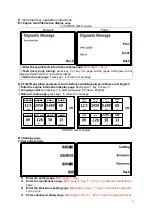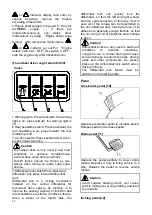
29
15.
Before driving over a dock-board or
bridge-plate, be sure that it is properly
secured and strong enough to sustain the
weight of the truck/load. Check the ground or
floor condition of working area in advance.
16.
Keep your mind on your work.
17.
Keep your head, hands, arms, feet and
legs within the cab. Never place them out of
the cab for any reason.
18.
When handling bulky loads which restrict
your vision, operate the truck in reverse or
have a guide.
19.
Slow down and sound horn at cross aisles
and other locations where vision is restricted.
The speed should be kept slower than 1/3 of
max speed.
20.
Keep fluid cans, row cotton, paper or
chemicals away from the truck during
operation since they may catch fire or explode
due to exhaust gas from the muffler.
21.
Use head lights and required work light
and clearance lights at night. Travel at a
slower speeds at night.
22.
The work surface should be solid and
level such as a cement road, asphalt or
concrete road surface.
For truck operation, the following climatic
conditions apply:
average ambient temperature for continuous
duty: + 25
°
C;
maximum ambient temperature, short term
(up to 1 h): + 40
°
C;
lowest ambient temperature for trucks
intended for use in normal indoor conditions:
+ 5
°
C;
lowest ambient temperature for trucks
intended for use in normal outdoor conditions:
°
C;
altitude: up to 2 000 m.
Caution
Inspect the surface over which truck will
operate.
Inspect
for
holes,
drop-offs,
obstacles, and rough spots. Look for
anything that might cause you to lose control
of the truck, or cause the truck to bog down
or turn over.
·Clear away trash and debris. Pick up
anything that might puncture the tires or
cause the load to become unbalanced
·Slow down when driving on wet and slippery
roads. Stay away from the shoulder of the
road. If you have to drive on the shoulder,
use extreme caution
·Rugged surfaces cause truck vibration and
noise. The high air pressure of the tires will
cause vibration and noise as well.

































